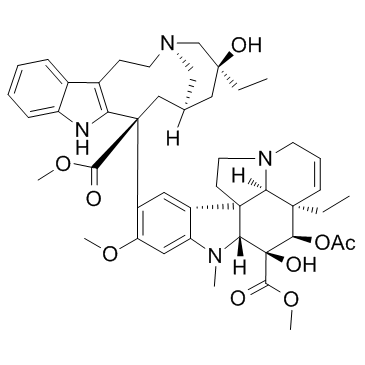865-21-4
| Name | vincaleukoblastine |
|---|---|
| Synonyms |
UNII-5V9KLZ54CY
vinblastine sulfuric acid salt Vincoblastine (3aR-(3aα,4β,5β,5aβ,9(3R*,5S*,7R*,9S*),10bR*,13aα))-methyl 4-(acetyloxy)-3a-ethyl-9-(5-ethyl-1,4,5,6,7,8,9,10-octahydro-5-hydroxy-9-(methoxycarbonyl)-2H-3,7-methanoazacycloundecino(5,4-b)indol-9-yl)-3a,4,5,5a,6,11,12,13a-octahydro-5-hydroxy-8-methoxy-6-methyl-1H-indolizino(8,1-cd)carbazole-5-carboxylate Vinblastine Vincaleucoblastin 1H-Indolizino(8,1-cd)carbazole-5-carboxylic acid, 4-(acetyloxy)-3a-ethyl-9-(5-ethyl-1,4,5,6,7,8,9,10-octahydro-5-hydroxy-9-(methoxycarbonyl)-2H-3,7-methanoazacycloundecino(5,4-b)indol-9-yl)-3a,4,5,5a,6,11,12,13a-octahydro-5-hydroxy-8-methoxy-6-methyl-, methyl ester, (3aR-(3aα,4β,5β,5aβ,9(3R*,5S*,7R*,9S*),10bR*,13aα))- Vincaleukoblastine Vinblastine,Vincaleukoblastine Rozevin Vincaleucoblastine Vinblastine sulphate EINECS 212-734-0 |
| Description | Vinblastine is a cytotoxic alkaloid used against various cancer types. Vinblastine inhibits the formation of microtubule and suppresses nAChR with an IC50 of 8.9 μM. |
|---|---|
| Related Catalog | |
| Target |
IC50: 8.9 μM(nAChR)[1] |
| In Vitro | Vinblastine does not depolymerize spindle microtubules, yet it powerfully blocks mitosis (for example, IC50 0.8 nM in HeLa cells) and cells die by apoptosis[2]. In NB4 cells, vinblastine produces alteration of p53 and DNA fragmentation. Vinblastine treatment has an antiproliferative effect via the induction of apoptosis producing Bax/Bcl-2 imbalance. Vinblastine treatment suppresses NFκB expression and depresses NFκB-DNA binding activity while maintaining JNK activation that subsequently results in apoptotic response through caspase-dependent pathway[3]. Vinblastine is found to trigger apoptosis as evidenced by the loss of mitochondrial membrane potential, the release of both cytochrome c and apoptosis inducing factor, activation of caspase-9 and 3, and cleavage of Poly (ADP-ribose)-Polymerase[4]. |
| In Vivo | Vinblastine is a widely used anticancer drug with undesired side effects. Its conjugation with carrier molecules could be an efficient strategy to reduce these side effects[5]. |
| References |
| Density | 1.4±0.1 g/cm3 |
|---|---|
| Melting Point | 211 - 216ºC |
| Molecular Formula | C46H58N4O9 |
| Molecular Weight | 810.974 |
| Exact Mass | 810.420349 |
| PSA | 154.10000 |
| LogP | 4.18 |
| Index of Refraction | 1.671 |
| Storage condition | -20C |
CHEMICAL IDENTIFICATION
HEALTH HAZARD DATAACUTE TOXICITY DATA
MUTATION DATA
|
| RIDADR | UN 1544 |
|---|---|
| Packaging Group | II |
| Hazard Class | 6.1(a) |
